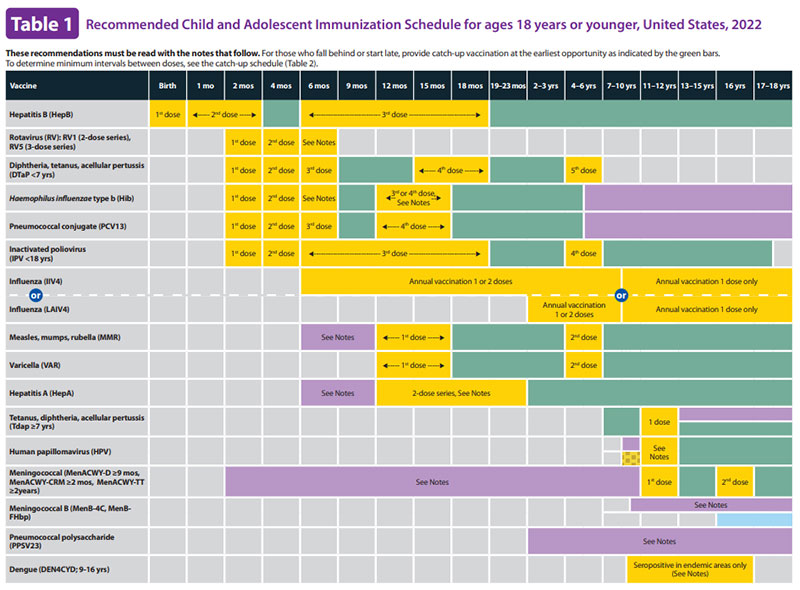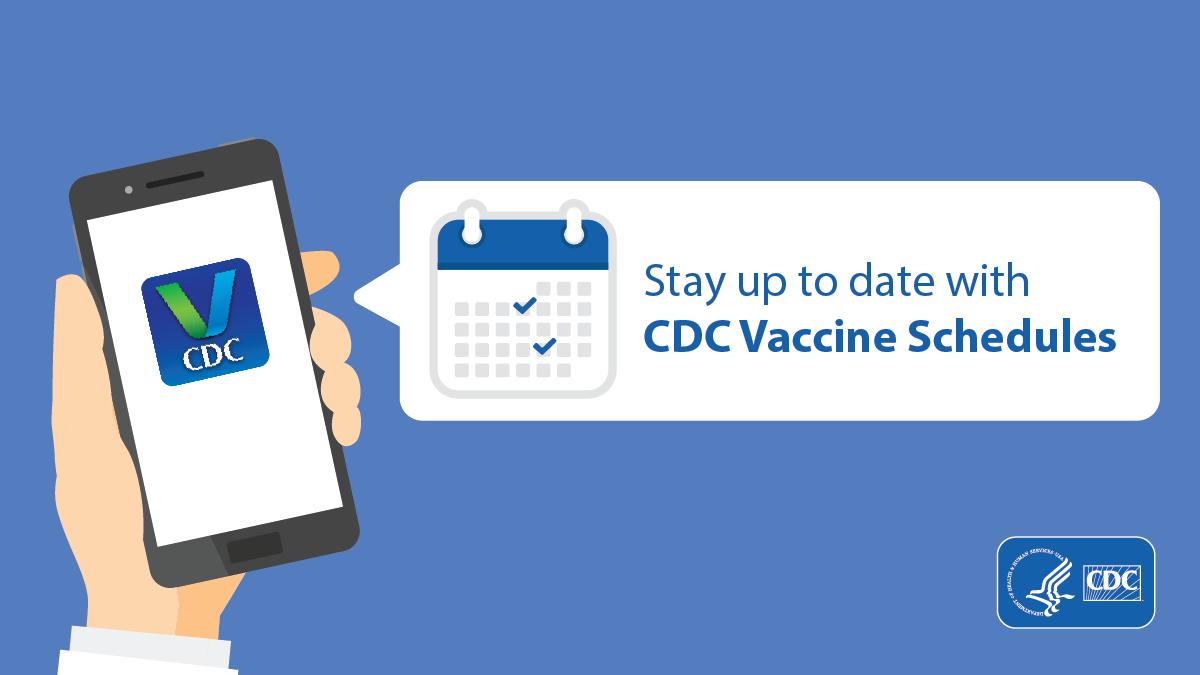CDC Immunization Schedule – Centers for Disease Control and prevention issue a CDC immunization schedule each year to ensure the safety of Americans from a huge number of deadly diseases.
The CDC immunization schedule includes vaccines starting from birth to death. A child might receive several vaccine shots, which will ensure the safety of the child from several diseases on the same day.
A lot of people get confused regarding the CDC immunization schedule, and they do not want to take any risks at the same time. That is why we came up with today’s blog to talk about everything related to the Centers for Disease Control and Prevention immunization schedule. We will also address the top questions.
CDC Immunization Schedule for 1st to 15th Month
Let’s start from the basics. The first 15 months after the birth of the baby is the most important ones. That is why the Center for Disease Control and Prevention has a separate CDC immunization schedule from birth to the 15th month of the baby.
As soon as the child is born, the doctors will give the first dose of the hepatitis B vaccine to the baby. Then the child is required to take the second dose of hepatitis B vaccine till the end of the second month. At the same time, the third dose has a bigger timeframe as it can be given from the 6th month all the way 15th month.
Once the child has completed the 60 days after the birth, it becomes eligible to receive several different vaccines. As per the schedule released by the Centers for Disease Control and Prevention, a child is eligible to receive the first dose of rotavirus, diphtheria, tetanus, acellular pertussis, and Haemophilus type b, Pneumococcal Conjugate, and inactivated poliovirus. You should get above given vaccines to your child in the second month.
The Centers for Disease Control and Prevention recommend the second dose of rotavirus, diphtheria, tetanus, acellular pertussis, Haemophilus type b, Pneumococcal Conjugate, and inactivated poliovirus vaccine once your child has completed the first four months.
Kindly remember, to get the second dose of rotavirus, diphtheria, tetanus, acellular pertussis, Haemophilus type b, Pneumococcal Conjugate, and inactivated poliovirus Vaccine, your child must be at least four months old and have already received its first dose of vaccine at least two months before taking the second dose.
Once the child has completed six months and already received the two doses of the above-given vaccines, then the child becomes eligible to receive 3rd or 4th dose of these vaccines till the 15th month.
For example, the child has at least one year to get the third dose of the vaccine for hepatitis B. A child can get the third dose of hepatitis B between six months to the 18th month.
After completing six months, your child is eligible to receive the third dose of diphtheria, tetanus, acellular pertussis, And Pneumococcal Conjugate vaccine.
While Centers for Disease Control and Prevention recommend the third dose of inactivated polio between 6 to 15th months after the birth. At the same time, a child also became eligible to receive the 4th dose of both diphtheria, tetanus, acellular pertussis, and Pneumococcal Conjugate.
After completing the six months, your child also becomes eligible to receive a few new vaccines as per the Centers for Disease Control and Prevention immunization schedule. Your child can receive one or two annual doses of influenza after completing the first six months.
As per the CDC immunization scheduler, a child can receive the first dose of Measles, Mumps, Rubella, and Varicella after completing 12 months. At the same time, center control and prevention also recommend a two-dose series for hepatitis A after completing the 1st year. But you should make sure there is at least a 12 months difference between taking two doses.

CDC Immunization Schedule for 18 Months to 18 Years
As soon as a child completes its 18 months, CDC immunization schedule requirements are to get the 4th dose of diphtheria, tetanus, acellular pertussis, And the third dose of inactivated poliovirus.
Centers for Disease Control and Prevention recommend 4th dose of inactivated poliovirus during the 4th to 6th year. At the same time, the child also becomes eligible to receive the 5th dose of diphtheria, tetanus, and acellular pertussis.
From the 18th month to the 6th year, the children also become eligible to finish the two-dose vaccine for influenza. At the same time, a child can also receive a second dose of Varicella and measles, Mumps, and rubella.
After completing ten years, a child became eligible to receive the first dose of meningococcal and Tetanus, Diphtheria & Acellular pertussis. At the same time, the Centers for Disease Control and Prevention recommend the second dose of meningococcal after the 16th year.
Kindly remember the Centers for Disease control and also recommend early vaccines for people who are at high risk and immune-compromised. At the same time, the CDC Immunization schedule also includes a range of recommended ages for catch-up vaccines.
CDC Immunization Schedule for Adults
CDC immunization schedules released by the Centers for Disease Control and prevention do not just focus on kids but also have separate schedules for adults.
First of all, CDC immunization schedules recommend one dose annually of influenza inactivated vaccine. It starts from age 19 to death. If you do not like to get the influenza inactivated vaccine, then you can also apply for influenza live attenuated, which is recommended till the 49th year.
At the same time, the Center for Disease Control and Prevention recommends booster doses of tetanus, Diphtheria, and pertussis Every ten years, starting from the 18th year to death.
If a person is born at 57 or later, the Center for Disease Control and Prevention recommends one or two doses depending on the indication of Measles, Mumps, and rubella till a person hits age 49.
For all the people born in 1980 or later, CDC immunization schedules for adults recommend two doses of Varicella With a nice gap of four to 8 weeks. At the same time, if a person is immune-compromised or in a high-risk group, then they can also take two additional doses after age 50.
Regardless of the year born, the Centers for Disease Control and Prevention recommend two doses of zoster recombinant once a person has completed age 50. If a person falls under the high-risk or immunocompromised category, then doctors can recommend two doses of convenience after completing 18 years.
Lastly, CDC immunization schedules for adults recommend a second, third, and 4th dose of hepatitis B depending on the vaccine or condition of the person. The sweet range of taking these three dosages is starting from the 18th to through the 50th.
New Developments in the CDC Immunization Schedule
In recent months, the Centers for Disease Control and prevention have mentioned that they are going to include the vaccine for COVID-19 in the CDC immunization schedule.
Presently, there are three different vaccines for COVID-19 that have been Organized by the Food and Drug Administration of the United States, but only two have been recommended by the Centers for Disease Control and prevention.
The most notorious vaccine for COVID-19 made by Johnson and Johnson has not been recommended by the Centers for Disease Control and prevention. Cases of blood clotting were reported a few months back, and now the Centers for Disease Control and prevention recommended Pfizer or Moderna vaccine over Johnson and Johnson.
As per the latest guidelines issued by the Center for Disease Control and prevention, everyone above the age of 5 is recommended to get two primary doses of the COVID-19 vaccine.
While everyone above the age of 12 is recommended to get the one booster dose along with two primary doses of the COVID vaccine. There must be at least a three weeks gap to get the second one of the primary series.
Takeaways
The Center for Disease Control and Prevention is trying to save every American from deadly diseases by recommending different vaccines in the CDC immunization schedule.
The CDC issues three separate CDC immunization schedules according to age group. The first age group and perceived immunization schedule are from birth to all the 18th month. The second age group starts from the 19th month to the 18th year. And the final age group is above 18th year till death.
In the above-given article, we have talked about every single age group separately, and we have also talked about how the Centers of Disease Control and Prevention have separated the doses throughout these age groups.
My child is at high risk of meningococcal. Can I ask the CDC to allow my child to get the vaccine as early as possible?
Yes, you can ask the Centers for Disease Control and prevention or the doctor of your child to give the meningococcal vaccine as early as possible. And to the current CDC immunization schedule, the first dose of the meningococcal vaccine is recommended after the 11th year. But, you can request the CDC, or if your doctor believes your child is at high risk, you might be eligible to get the first or second dose after the second month of birth
